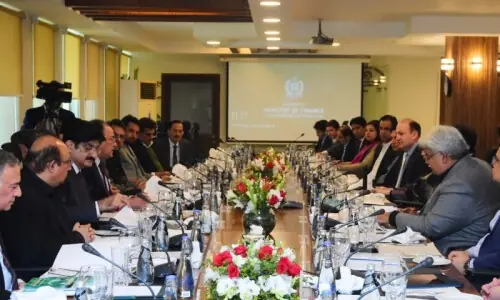
PAKISTAN has turned down a key Chinese demand to allow the use of yuan in the Gwadar free trade zone under the China-Pakistan Economic Corridor (CPEC) framework.
The rejection came at the senior officials’ meeting held in Islamabad on Nov 20, according to media reports. But it is not known whether the Chinese authorities pressed for the acceptance of this demand the following day at the joint cooperation committee (JCC), the highest-level decision-making committee of the two countries.
Despite Pakistan’s rejection of the Chinese proposal on allowing a limited use of yuan in the Gwadar free trade zone, what perturbs media persons and parliamentarians alike is why the government does not clarify such key issues.
Despite Pakistan’s rejection of the Chinese proposal on allowing limited use of yuan, what perturbs most is the question of why the government doesn’t clarify key issues
“The media has already reported that we’ve rejected the Chinese demand,” said an official of the Ministry of Finance when asked to confirm the status of the yuan proposal. “Whatever transpired in the two-day meetings is public. This much is for now.”
“But we are in the process of finding ways to keep media informed about all CPEC developments on a regular basis,” said an official of the Ministry of Planning and Development.
Sources in the State Bank of Pakistan (SBP) say that a currency-swap arrangement made with China towards the end of 2011 become operational back in May 2013.
Under that agreement, the SBP could purchase yuans from the Peoples Bank of China (PBC), and the PBC could in turn buy the rupee against the yuan for a certain period. Both central banks could then lend currencies thus purchased to their banks through auctions, enabling the banks to use yuan or rupee-denominated funds to settle their client’s trade claims.
This currency-swap arrangement is now expected to be renewed, bankers say. Much depends on the size of the swap limit and also on whether the funds flowing from the swap facility will be used only for settling Pakistan-China bilateral trade claims or whether they can also be used for CPEC-related investment in Gwadar.
The CPEC long-term plan has already been approved, with the deputy chairman of the Planning Commission, Sartaj Aziz, reconfirming this fact on Nov 29 while talking to a Chinese delegation. This plan also contained a proposal for the use of yuan in the Gwadar free trade zone.
While Mr Aziz’s meeting with the Chinese delegation received full media coverage, no remarks have been attributed to him about the status of the proposal.
If Pakistan has rejected the proposal at the senior officials’ meeting on Nov 20, and if the matter was not raised again at the joint action committee’s meeting held the very next day, Mr Aziz should have informed journalists about it. Hence an aura of mystery shall remain around this issue until one of the governments address it in unambiguous, plain words.
According to Mr Aziz, the first phase of the CPEC-related investment is no less than $30 billion, whereas the total investment commitments have exceeded $60bn. The break-up of $30bn or $60bn investment pledges in terms of financial arrangement (debt, investment, swaps, etc) have yet to become public knowledge.
This makes it difficult for independent economists to analyse the financial obligations that CPEC will create for Pakistan, already struggling with a ballooning current account deficit.
Amid this situation, it has become imperative that everything about the CPEC becomes transparent as secrecy shall only serve to undermine the project’s success.
This was, perhaps, the spirit behind all the criticism heard in the Senate last week. And senators who demanded greater transparency in CPEC-related matters had some reason to do so. Federal Minister for Ports and Shipping Mir Hasil Bizenjo shocked the senators by revealing that 91pc of the revenues generated from Gwadar port would go to China while the Gwadar Port Authority would get only nine per cent. This arrangement would remain in place for the next 40 years.
Media has been stressing this point, lawmakers have been calling for it and now even business associations are demanding greater transparency.
According to a report published in this newspaper, in a document titled Agenda for the Economy released on Nov 29, the Pakistan Business Council notes: “There needs to be greater transparency on how the CPEC will impact the competitiveness of existing domestic industries and the safeguards that will be deployed to prevent it from becoming a channel of cheap imports.”
Last week, Railways Minister Khawaja Saad Rafique reportedly stated before the Senate standing committee on Railways that China was earlier offering soft loans for Railways but is now hesitant in so doing and “is talking about mixed loans”.
He was quoted by a local newspaper as having informed the committee that the railways needed long-term loan with a long grace period at below two per cent annual interest rate.
“If China is not giving (loans) at certain (interest rate) level and (under) favourable conditions, Pakistan Railways will not take over $8bn (loans) under the CPEC agreement,” he was quoted as saying.
Published in Dawn, The Business and Finance Weekly, December 4th, 2017

































